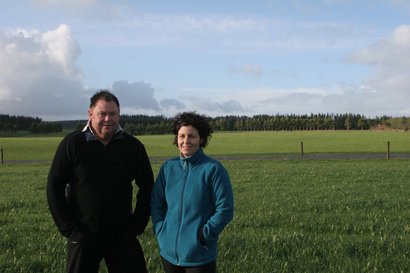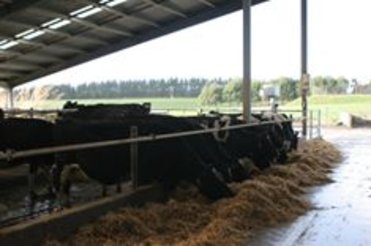Wintering barn saves soaked Southland pastures from treading
Hedgehope 29 June: It’s been a wet, cold June on the Murdoch’s Southland farm but in-calf cows are dry literally as well as figuratively, and pastures are safe from treading damage thanks to the wintering barn Blair and Rebecca built in 2008, plus a feedpad.
“Without the barn it was harder going,” Blair says. “This is quite a wet property for a start, plus we always had to graze our young stock away, and the cows were wintered off as well every winter. Now we have all our stock here; we can feed supplement with very little wastage through the barn and we have full control over everything. It’s a little bit more work but we’re getting everything grown out to potential now.”
As a System 5 business, they also have a big feed bill, but they’ve been able to cut that this winter by replacing half the amount of distillers’ grain they initially planned to use with PKE, which is about half the price, saving approximately $100,000.
Other than that, the status quo feed wise will prevail until Christmas, when they will review things if necessary.

By that time, Blair says, there will hopefully be some more clarity about the way milk prices are headed, and the critical spring period will have been taken care of. “We have to calve them down right, and we have to get them back in calf. After that we can review things, but there won’t be any changes before.”
Blair and rebecca in a young Trojan/Bealey paddock
Because stock are virtually off grass over winter, pasture focus is very important in the autumn, setting up covers for the paddocks that will carry springers from July and making sure nothing gets too much cover on it before it can be grazed again.
Barenbrug agronomist Janet Montgomery says it’s a fine balancing act, especially with the changeable weather; so far Blair’s happy with the way things are looking, with average farm cover at about 2000 kg DM/ha.
New paddocks of Trojan/Bealey mix sown in autumn are looking great, with good clover content and lots of plantain. The Murdochs like this mix – they’re big fans of tetraploids like Bealey for growth and palatability, but with heavy land prone to pugging, Trojan helps to give the soil a little more stability.
Two ex-crop (kale) paddocks will be sown in the spring, and a further two as well – usually these would go into barley for whole crop, but they might go grass to grass next year because of the low payout.
 Blair’s still milking about 140 cows for winter milk; they’ve just gone onto OAD and will be dried off in a couple of weeks. By then it will be time to start transitioning the cows that were dried off first on 1 June, which are due to start calving 25 July.
Blair’s still milking about 140 cows for winter milk; they’ve just gone onto OAD and will be dried off in a couple of weeks. By then it will be time to start transitioning the cows that were dried off first on 1 June, which are due to start calving 25 July.
This extended lactation means the Murdochs will probably produce about 10,000 kg MS in June, a pattern which provides better winter cashflow while also meeting their goal of a 300-305 day lactation. They receive a premium for this, and say with the rise of barns there is more winter milk coming out of Southland than many people realise, but the
economics are not as good this year as they Dry cows in their new wintering barn
have been previously.

Most of the dry cows are at or near calving condition now, so it’s a matter of keeping them full, but not fat. Currently they’re being fed 4 kg straw, 5 kg silage and 1 kg soy bean meal, which is relatively cheap and ensures adequate protein intake. All up the Murdochs will calve 610 cows this spring.
Both Blair and Rebecca say a highlight of the winter so far was a whirlwind trip to the USA, courtesy of Altech, which gave them the opportunity to visit several Californian dairy farms as well as attend the company’s huge international conference in Kentucky. “It was pretty amazing,” Blair says. “We met farmers from all over the world. We came home thinking we’re not in a bad place to farm – the biggest issue is that we’re not getting paid enough for our product.”

